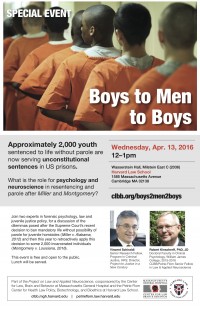CLBB’s Dr. Robert Kinscherff offers commentary on the changing landscape of juvenile justice, especially for offenders who were previously serving life sentences without parole. In this new FRONTLINE documentary, “Second Chance Kids”, he discusses the implications of the Supreme Court ruling that changed everything (Miller v. Alabama) and the role neuroscience research played in shaping such a monumental decision. The following article (also quoting Dr. Kinscherff) accompanied the FRONTLINE documentary.
Continue reading »
WATCH — Second Chance Kids
- Category: Events
- Tags: adolescent brain | juvenile justice | miller v. alabama | robert kinscherff
- Date: May 2, 2017
- Author: FRONTLINE
WATCH — Boys to Men to Boys
Approximately 2,000 youth sentenced to life without parole are now serving unconstitutional sentences in US prisons. What is the role for psychology and neuroscience in re-sentencing and parole after Miller and Montgomery?
Join two experts in forensic psychology, law and juvenile justice policy, for a discussion of the dilemmas posed after the Supreme Court’s recent decision to ban mandatory life without possibility of parole for juvenile homicides (Miller v. Alabama, 2012) and then this year to retroactively apply this decision to some 2,000 incarcerated individuals (Montgomery v. Louisiana, 2016).
The event will be held at 12:00 pm on Wednesday, April 13, in Wasserstein Hall, Milstein East C (2036) at Harvard Law School (1585 Massachusetts Avenue, Cambridge, MA).
This event is free and open to the public. Lunch will be served.
- Category: Events
- Tags: juvenile justice | miller v. alabama | montgomery v. louisiana | robert kinscherff | sentencing | vincent schiraldi
- Date: March 30, 2016
- Author: admin2
Justices Expand Parole Rights for Juveniles Sentenced to Life for Murder
Over the past decade, the Supreme Court has issued a series of landmark decisions around the criminal culpability of adolescents, drawing from neuroscience research. In 2005, the Court abolished the juvenile death penalty. In 2010, the Court banned life without parole for juveniles convicted of crimes other than homicide. And in 2012, the Court prohibited states from mandating life without parole for any crimes committed by minors. On Monday, the Supreme Court ruled that its 2012 decision must be applied retroactively, impacting over 2,000 people currently serving life sentences.
By Adam Liptak | The New York Times | January 25, 2016
The Supreme Court on Monday ruled that its 2012 decision banning mandatory life-without-parole sentences for juvenile killers must be applied retroactively, granting a new chance at release for hundreds of inmates serving life sentences without the possibility of parole for murders they committed in their youth.
The vote was 6 to 3, and the majority decision was written by Justice Anthony M. Kennedy, the court’s leading proponent of cutting back on the death penalty and other harsh punishments for entire classes of offenders. His opinion strengthened the 2012 decision, which merely required new sentencing where life without parole had been imposed automatically, without taking into account the defendant’s youth.
Monday’s opinion indicated that life-without-parole sentences for juvenile offenders should be exceedingly rare. Justice Kennedy also gave states a second option — instead of resentencing the affected prisoners, they could make them eligible for parole. Continue reading »
- Category: News
- Tags: adolescent brain | juvenile justice | miller v. alabama | Supreme Court
- Date: January 25, 2016
- Author: The New York Times




